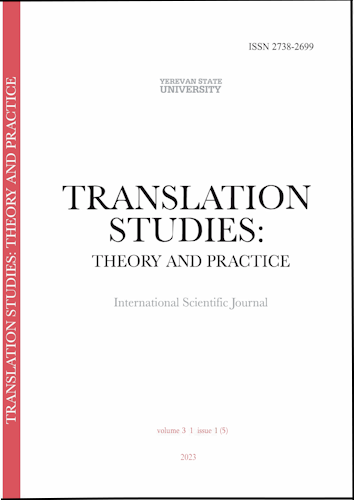The Relationship between Translated Fairy Tales and Oral Narrative Tradition: Charles Perrault’s Contes in Georgian Folklore
DOI:
https://doi.org/10.46991/TSTP/2023.3.1.027Keywords:
folktales, fairy tales, Little Red Riding Hood, Little Thumb, GeorgiaAbstract
What does put Little Red Riding Hood in her basket when she arrived in Georgia? What was the name of that demonic antagonist who met Little Thumb? An overview of archival sources gives an account of characteristics of Georgian folkloric adaptations of Charles Perrault's fairy tales. The paper deals with transmissions between the categories of "oral" and "literary", and relations between translated print products and oral narratives. The comparison of literary and folkloric versions of fairy tales shows certain features that are universal and serve as a medium between the literature and oral narrative traditions.
References
Apo, Satu. 2007. “The Relationship between Oral and Literary Tradition as a Challenge in Fairy-Tale Research: The Case of Finnish Folktales.” Marvels & Tales, Vol. 21, No. 1, 19-33.
Bottigheimer, Ruth B. 2002. Fairy godfather: Straparola, Venice, and the fairy tale tradition. Pennsylvania: University of Pennsylvania Press.
Clausen-Stolzenburg, Maren. 1995. Märchen und Mittelalterliche Literaturtradition. Heidelberg: Winter.
Dégh, Linda. 1962. Erzähler und Erzählgemeinschaft dargestellt an der ungarischen Volksüberlieferung. Berlin: Akademie-Verlag.
Database of Georgian Folklore. Author of the idea and the project research director: Elguja Dadunashvili. http://www.folktreasury.ge/ARPA/ 18.02.2022.
Grätz, Manfred. 1988. Das Märchen in der deutschen Aufklärung. Vom Feenmärchen zum Volksmärchen. Stuttgart: Metzler.
Grimm's Fairy Stories. 1922. Colored Illustrations by John B. Gruelle. New York: Cupples and Leon.
Grimm Brothers. 2004. Household Tales by Brothers Grimm. Translator Margaret Hunt. The Project Gutenberg eBook https://www.gutenberg.org/files/5314/5314-h/5314-h.htm#chap26 Release Date: March, 2004 [eBook #5314] last seen 08.01.2023
Kaliambou, Maria. 2007. “The Transformation of Folktales and Fairy Tales into Popular Booklets.” Marvels & Tales, Vol. 21, No. 1, 50-64.
Karlinger, Felix. 1983. Grundzüge einer Geschichte des Märchens im deutschen Sprachraum. Darmstadt: Wissenschaftliche Buchgesellschaft.
Malarte-Feldman, Claire-Lise. 1999. “The Challenges of Translating Perrault's ‘Contes’ into English.” Marvels & Tales, Vol. 13, No. 2, 184-198.
Nadales, María Rosal. (2019). “Retellings of tradition. Little Red Riding Hood and the voice of the wolf.” Fabula, 60 (3-4), 244-262. https://doi.org/10.1515/fabula-2019-0016
Ong, Walter J. 2002. Orality and Literacy. The Technologizing of the World. London and New York: Routledge.
Perrault, Charles. 1867. Volshebnye skazki Perrault [The Fairy Tales of Charles Perrault]. Translated by Ivan Turgenev. Sanct-Petersbourg/Moscow/Leipzig: M.O.Wolf.
Perrault, Charles. 1922. The Fairy Tales of Charles Perrault. Illustrated by Harry Clark with an introduction by Thomas Bodkin. London: George G. Harrap & Co.
Perrault, Charles. 1938. Zgaprebi [Fairy tales]. Translated from French by Geronti Kikodze. Tbilisi: Sakhelgami.
Perrault, Charles. 1897. Fairy tales with nine illustrations, portraits and biography. Saint-Petersburg: Obshetv. polza.
Perrault, Charles. 1908. Krasnaja shapochka i dr. [Fairy tales]. Adapted by E.V. Ignatovich. Saint-Petersburg: Mannstein.
Perrault, Charles. 2022. Zgaprebi [Fairy tales].. Translated by Geronti Kikodze, Mariam Pareshishvili. Tbilisi: Palitra L.
Perrault, Charles. 2021. Zgaprebi [Fairy tales]. Translated by Maia Shvelidze. Tbilisi: Palitra L.
Perrault, Charles. 2017. Zgaprebi [Fairy tales]. Translated by Ana Abashidze. Tbilisi: Elfi, 2017.
Propp, Vladimir 1968. Morphology of the Folktale. Translated by Laurence Scott. 2nd edition. Austin: University of Texas Press.
Röhrich, Lutz. 1964. Märchen und Wirklichkeit. Wiesbaden: Franz Stainer Verlag.
Rötzler, Hans Gerd. 1972. Der Roman des Barok 1600-1700. Kommentar zu einer Epoche. München: Winkler Verlag.
Schenda, Rudolf. 1970. Volk ohne Buch. Studien zur Sozialgeschichte der populären Lesestoffe 1770–1910, Frankfurt am Main: Klostermann.
Schenda, Rudolf. 1976. Die Lesestoffe der Kleinen Leute. Studien zur populären Literatur im 19. und 20. Jahrhundert. München: C. H. Beck.
Thompson, Stith 1975. Motif-Index of Folk-Literature: A Classification of Narrative Elements in Folktales, Ballads, Myths, Fables, Mediaeval Romances, Exempla, Fabliaux, Jest-Books and Local Legends. Indiana University Press.
Uther, Hans-Jörg 2004. The Types of International Folktales: A Classification and Bibliography. Based on the System of Antti Aarne and Stith Thompson, Parts 1–3. Helsinki, Academia Scientiarum Fennica.
Verdier, Yvonne. 1997. “Little Red Riding Hood in Oral Tradition.” Marvels & Tales, Vol. 11, No. 1/2, 101-123.
Ziolkowksi, Jan M. 2010. “Straparola and the Fairy Tale: Between Literary and Oral Traditions.” Journal of American Folklore 123(490), 377-397.
Zipes, Jack David 2006. Why fairy tales stick: the evolution and relevance of a genre. New York and London: Routledge.
Zipes, Jack (ed.). 1993. The Trials and Tribulations of Little Red Riding Hood. New York/London: Routledge.
Downloads
Published
How to Cite
Issue
Section
License
Copyright (c) 2023 Elene Gogiashvili

This work is licensed under a Creative Commons Attribution-NonCommercial 4.0 International License.










